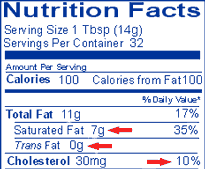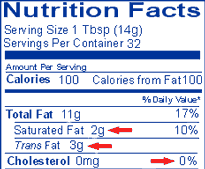What are trans fats

The lipid shown here is the trans fat elaidic acid -- the trans isomer of oleic acid a major trans fat found in hydrogenated vegetable oils,
What are fats and fatty acids? Fats are a group of chemical compounds that contain fatty acids. Energy is stored in the body mostly in the form of fat. Fat is also needed in the diet to supply essential fatty acids that are substances essential for growth but not produced by the body itself. The terms fat and fatty acids are frequently used interchangeably. What are the main types of fatty acids? There are three main types of fatty acids: saturated, monounsaturated and polyunsaturated. All fatty acids are chains of carbon atoms with hydrogen atoms attached to the carbon atoms. A saturated fatty acid has the maximum possible number of hydrogen atoms attached to every carbon atom. It is therefore said to be "saturated" with hydrogen atoms, and all of the carbons are attached to each other with single bonds. In some fatty acids, a pair of hydrogen atoms in the middle of a chain is missing, creating a gap that leaves two carbon atoms connected by a double bond rather than a single bond. Because the chain has fewer hydrogen atoms, it is said to be "unsaturated." A fatty acid with one double bond is called "monounsaturated" because it has one gap. Fatty acids having more than one gap are called "polyunsaturated." The fat in foods contains a mixture of saturated, monounsaturated and polyunsaturated fatty acids. In foods of animal origin, a large proportion of fatty acids are saturated. In contrast, in foods of plant origin and some seafood, a large proportion of the fatty acids are monounsaturated and polyunsaturated. The structure of saturated and unsaturated chemical bonds looks like the diagram below.
What is trans fat? Basically, trans fat is made when manufacturers add hydrogen to vegetable oil--a process called hydrogenation. Hydrogenation increases the shelf life and flavor stability of foods containing these fats. Trans fat can be found in vegetable shortenings, some margarines, crackers, cookies, snack foods, and other foods made with or fried in partially hydrogenated oils. Unlike other fats, the majority of trans fat is formed when food manufacturers turn liquid oils into solid fats like shortening and hard margarine. A small amount of trans fat is found naturally, primarily in some animal-based foods. Trans fat behaves like saturated fat by raising low-density lipoprotein (LDL or "bad") cholesterol that increases your risk of coronary heart disease (CHD). Trans fat can be found in some of the same foods as saturated fat, such as vegetable shortenings, some margarines, crackers, candies, cookies, snack foods, fried foods, baked goods, and other processed foods made with partially hydrogenated vegetable oils. Trans fat is made when hydrogen is added to vegetable oil -- a process called hydrogenation. Hydrogenation increases the shelf life and flavor stability of foods containing these fats. Usually the hydrogen atoms at a double bond are positioned on the same side of the carbon chain. However, partial hydrogenation reconfigures some double bonds and the hydrogen atoms end up on different sides of the chain. This type of configuration is called "trans" (means "across" in Latin). The structure of a trans unsaturated chemical bond looks like the diagram below.
Trans fat, like saturated fat and dietary cholesterol, raises the LDL cholesterol that increases your risk for CHD. Americans consume on average 4 to 5 times as much saturated fat as trans fat in their diets. Where will I find trans fat? As stated in FDA's labeling regulations, if a fat or oil ingredient is completely hydrogenated, the name in the ingredient list will include the term "hydrogenated." Or, if partially hydrogenated, the name in the ingredient list will include the term "partially hydrogenated." As stated above, oil that is partially hydrogenated is a source of trans fat. Unlike other fats, the majority of trans fat is formed when liquid oils are made into solid fats like shortening and hard margarine. However, a small amount of trans fat is found naturally, primarily in some animal-based foods. Essentially, trans fat is made when hydrogen is added to vegetable oil -- a process called hydrogenation. Hydrogenation increases the shelf life and flavor stability of foods containing these fats. Although saturated fat is the main dietary culprit that raises LDL, trans fat and dietary cholesterol also contribute significantly. Trans fat can often be found in processed foods made with partially hydrogenated vegetable oils such as vegetable shortenings, some margarines (especially margarines that are harder), crackers, candies, cookies, snack foods, fried foods, and baked goods.
*Nutrient values rounded based on FDA's nutrition labeling regulations. Are All Fats the Same? Simply put: no. Fat is a major source of energy for the body and aids in the absorption of vitamins A, D, E, and K, and carotenoids. Both animal and plant-derived food products contain fat, and when eaten in moderation, fat is important for proper growth, development, and maintenance of good health. As a food ingredient, fat provides taste, consistency, and stability and helps us feel full. In addition, parents should be aware that fats are an especially important source of calories and nutrients for infants and toddlers (up to 2 years of age), who have the highest energy needs per unit of body weight of any age group. Saturated and trans fats raise LDL (or "bad") cholesterol levels in the blood, thereby increasing the risk of heart disease. Dietary cholesterol also contributes to heart disease. Unsaturated fats, such as monounsaturated and polyunsaturated, do not raise LDL cholesterol and are beneficial when consumed in moderation. Therefore, it is advisable to choose foods low in saturated fat, trans fat, and cholesterol as part of a healthful diet. Where Can I Find Trans Fat on the Food Label?Consumers can find trans fat listed on the Nutrition Facts panel directly under the line for saturated fat.
|
||||||||||||||||||||||||||||||||||||||||||||||||||||||||||||||||||||||||||||||||||||||||||||||||||||||||||||||||||||||||||||||||||||||||||||||||||||||||||||||||||||||||||||||||||||||||
Fats in Cooking and Health
- What are the differrent types of fatty acids?
- What are Trans Fats?
- What is the difference between LDL and HDL?
- What are the different types of omega 3 fatty acid?
- What are omega-6 fatty acids?
- The importance of the ratio of omega-6/omega-3 essential fatty acids
- What is the difference between saturated and unsaturated fats?
- What causes oils to go rancid?
- What are essential fatty acids?
- Duck Fat as an alternative to butter
- How to render duck fat
- Did butter get a bad rap?
Types of Fatty Acids
Saturated
 __
__